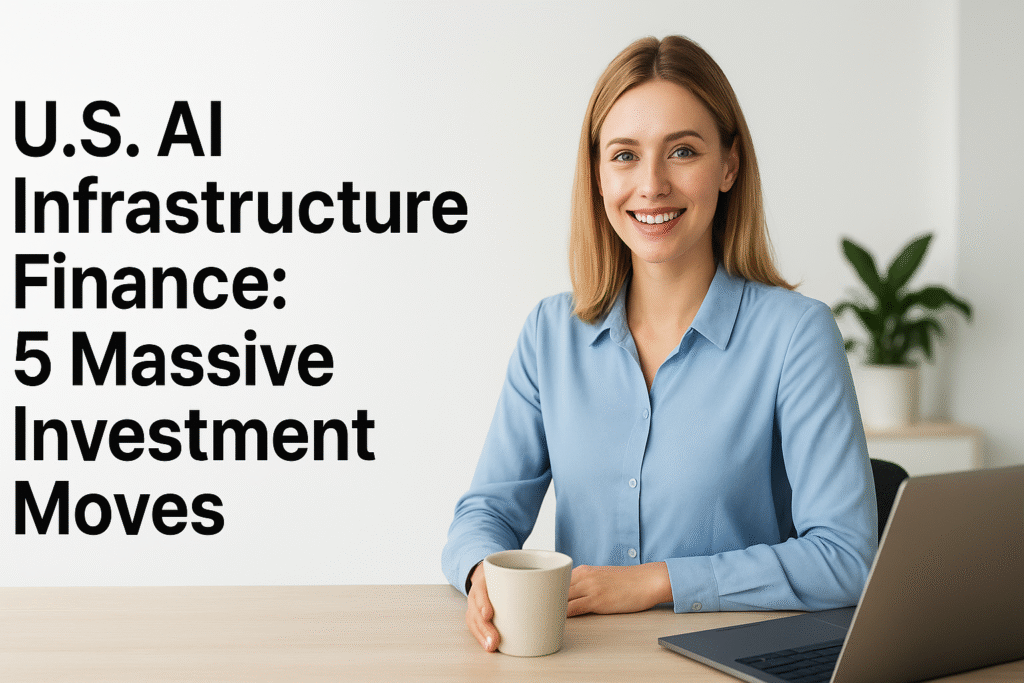The U.S. AI infrastructure finance sector is exploding. Hyperscalers like Google, Microsoft, and Amazon Web Services are pouring billions into building AI-ready data centers—but the cost of scaling artificial intelligence at a national level is astronomical.
The Financial Times estimates that global AI-related data center spending could hit $3 trillion by 2029, with a $1.5 trillion funding gap in the U.S. alone. That’s where private capital, innovative financing structures, and even non-traditional investors are stepping in.
In this guide, we’ll break down the 5 biggest investment moves shaping AI’s physical backbone right now, show you how everyday investors can benefit, and explore what this means for the future of AI economics.

- 1. Private Equity Fills the AI Funding Gap
- 2. CoreWeave’s $65 Billion Rise
- 3. The $3 Trillion Global Build-Out
- 4. SVMCO Inc. – Financing AI Startups
- 5. Concentrated Capital and Risk Management
- How Everyday Investors Can Participate-U.S. AI infrastructure finance
- Conclusion-U.S. AI infrastructure finance
- FAQs-U.S. AI infrastructure finance
- Affiliate & Legal Disclaimer
1. Private Equity Fills the AI Funding Gap
Focus keyword: U.S. AI Infrastructure Finance
The AI boom isn’t just about algorithms—it’s about the infrastructure to run them. From GPU-rich data centers to high-speed fiber networks, scaling AI requires billions in capital outlay. Traditionally, hyperscalers have financed these builds themselves, but 2025 marks a turning point:
Private equity giants like Apollo Global Management, KKR, and Blackstone are stepping in with structured debt and leaseback agreements. This allows tech companies to keep innovating without draining their balance sheets.
💡 Investor Tip: This trend is driving demand for REITs (Real Estate Investment Trusts) specializing in digital infrastructure, such as Digital Realty and Equinix.
2. CoreWeave’s $65 Billion Rise
CoreWeave, once a niche cloud provider, has become a cornerstone of AI infrastructure. Backed by private investors and leveraging NVIDIA GPU resources, the company recently secured funding that pushed its valuation above $65 billion.
This meteoric rise signals investor confidence in specialized cloud operators that focus on AI workloads rather than general-purpose computing.
Related Resource:
📘 The Intelligent Investor – Learn how to evaluate long-term value in emerging markets.
Buy on amazon.com (Sponsored)
3. The $3 Trillion Global Build-Out
Between now and 2029, AI will drive the largest infrastructure expansion since the industrial revolution. AI-ready data centers cost up to 50% more to build than standard ones, thanks to power density requirements and specialized cooling systems.
Major forecasts indicate that U.S. spending alone could exceed $750 billion by 2026, with the rest of the world catching up fast. The funding gap presents opportunities for:
- Infrastructure ETFs
- AI-focused corporate bonds
- Private placement investment vehicles

ClickBank Mindset Tools That Accelerated My Growth
These digital products helped me shift from knowledge to results — fast.
Rewire your subconscious for wealth and clarity — built by an 8-figure marketer.
Activate deep focus and manifestation with this neuroscience-inspired audio tool.
Reset your energy and mindset with this high-converting manifestation VSL.
4. SVMCO Inc. – Financing AI Startups
SVMCO Inc., dubbed the “Bloomberg of AI-powered business scaling,” recently launched a platform to help AI startups secure both debt and equity financing with AI-driven analytics.
This hybrid model may reshape early-stage funding, allowing smaller AI firms to scale without relying solely on venture capital.
Affiliate Pick:
📊 Quicken Simplifi Personal Finance Software – Track your investments, spending, and AI-related portfolio performance.
Get it on amazon.com (Sponsored)
5. Concentrated Capital and Risk Management
Despite record investment, AI funding remains highly concentrated. Just 10 companies account for 35% of all private capital in the sector.
This raises the risk of asset obsolescence—especially as AI chip technology evolves rapidly. Investors need to diversify and understand that infrastructure risk isn’t just financial, but technological.

How Everyday Investors Can Participate–U.S. AI infrastructure finance
- Digital Infrastructure REITs – Stable dividend income from AI data center leases
- Tech Infrastructure ETFs – Diversified exposure without single-company risk
- AI-Themed Crowdfunding – Early-stage participation in smaller AI hardware projects
ClickBank Opportunity:
💼 AI Profits Blueprint – A digital course teaching how to profit from AI-driven investment trends.
Access here (Sponsored)
Conclusion–U.S. AI infrastructure finance
The U.S. AI Infrastructure Finance landscape is being rewritten before our eyes. What was once the sole domain of tech giants is now attracting private equity, REITs, and alternative financiers.
For investors, the key takeaway is clear: this isn’t just an AI revolution in software—it’s a trillion-dollar transformation in hardware, real estate, and energy systems.

FAQs–U.S. AI infrastructure finance
Q1: What drives U.S. AI infrastructure finance growth?
The need for massive, specialized data centers with high GPU capacity and advanced cooling drives both private and institutional investment.
Q2: Is AI infrastructure a safe long-term investment?
While returns can be strong, risks include rapid obsolescence of hardware and shifts in AI processing needs.
Q3: How can small investors participate?
Through REITs, ETFs, and carefully chosen AI-themed funds.
Q4: What’s the role of private equity?
They provide alternative financing structures, enabling hyperscalers to expand without overleveraging.
Q5: Will AI infrastructure demand keep growing?
Yes—AI adoption in medicine, finance, and industry guarantees sustained demand through the next decade.
Affiliate & Legal Disclaimer
This article relies on internal data, publicly available information, and other reliable sources. It may also include the authors’ personal views. However, it’s essential to note that the information is for general, educational, and awareness purposes only—it doesn’t disclose every material fact. This analysis is for informational purposes only and does not constitute financial advice. Consult a professional before making investment decisions. This article contains affiliate links from Amazon and ClickBank. If you purchase through these links, we may earn a commission—at no extra cost to you.
We publish information on World Virtual CFO in good faith, solely for general information. World Virtual CFO doesn’t guarantee the completeness, reliability, or accuracy of this information. These are our views for informational purposes. When you use our website, know that any action you take is entirely at your own risk. World Virtual CFO won’t be liable for any losses or damages connected to your use of our website. For detailed information, refer to our disclaimer page.
Dr. Dinesh Sharma is an award-winning CFO and AI strategist with over two decades of experience in financial leadership, digital transformation, and business optimization. As the founder of multiple niche platforms—including WorldVirtualCFO.com—he empowers professionals and organizations with strategic insights, system structuring, and innovative tools for sustainable growth. His blogs and e-books blend precision with vision, making complex financial and technological concepts accessible and actionable.
